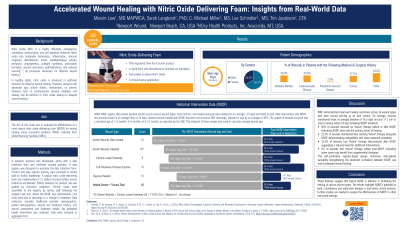Case Series/Study
(CS-067) Accelerated Wound Healing with Nitric Oxide Delivering Foam: Insights from Real-World Data
Friday, May 2, 2025
7:45 PM - 8:45 PM East Coast USA Time

Mervin Low, MD- Plastic Surgery; Sarah Griffiths Langbord, PhD.- NOxy Health Products; C. Michael Miller, MS- NOxy Health Products; Tim Jacobson, CFA- NOxy Health Products
Introduction: Nitric oxide (NO) plays a critical role in the regulation of various wound healing processes, including perfusion, inflammatory response, cell proliferation, collagen formation, antimicrobial action, angiogenesis, wound contraction, and epithelialization.1-3 For patients with chronic or critical illness, NO bioavailability is reduced, resulting in delayed wound healing.1,2 Despite a large body of evidence supporting the benefits of supplemental NO, there were no available NO delivering products available for wound treatment prior to introduction of the study product. The aim of this study was to observe treatment time among patients with chronic wounds before and after being treated with a topical nitric oxide-delivering foam (NODF).
Methods: A research protocol, data collection form, and informed consent form were developed. A data registry was designed and automated. After product and registry training, the NODF was implemented in 21 skilled nursing facilities. Patient selection was guided by physician judgement. Clinical cases were entered into the registry by facility staff. Data were analyzed in aggregate form.
Results: Data analysis included 54 clinical cases, representing severe wounds (full-thickness pressure injuries (FTPI) and lower extremity wounds such as DFUs, VLUs, and Arterial Ulcers) and trauma wounds. Clinicians recorded the age of the wound as 1-3 months, 4-6 months, or 6-12 months. The midpoint of these ranges was used to calculate the wounds age (1-3 months = 60 days, 4-6 months = 135 days, 6-12 months = 270 days). Of the 54 cases, 40 chronic severe, lower-extremity, FTPI, and trauma wounds persisted for 77 days on average before being treated with NODF. All 40 wounds (with an average initial size of 12cm2) healed in an average of 24 days. The other 14 wounds persisted for 90 days on average before being treated with NODF. These 14 wounds were treated with NODF for an average 35 days before treatment was stopped (typically due to discharge) and experienced a 49% reduction in the size of the wound on average.
Discussion: This data suggests that the topical NODF moves wounds from a chronic trajectory into a healing trajectory. This suggests using NODF to treat chronic wounds of multiple etiologies can improve patient outcomes.
Methods: A research protocol, data collection form, and informed consent form were developed. A data registry was designed and automated. After product and registry training, the NODF was implemented in 21 skilled nursing facilities. Patient selection was guided by physician judgement. Clinical cases were entered into the registry by facility staff. Data were analyzed in aggregate form.
Results: Data analysis included 54 clinical cases, representing severe wounds (full-thickness pressure injuries (FTPI) and lower extremity wounds such as DFUs, VLUs, and Arterial Ulcers) and trauma wounds. Clinicians recorded the age of the wound as 1-3 months, 4-6 months, or 6-12 months. The midpoint of these ranges was used to calculate the wounds age (1-3 months = 60 days, 4-6 months = 135 days, 6-12 months = 270 days). Of the 54 cases, 40 chronic severe, lower-extremity, FTPI, and trauma wounds persisted for 77 days on average before being treated with NODF. All 40 wounds (with an average initial size of 12cm2) healed in an average of 24 days. The other 14 wounds persisted for 90 days on average before being treated with NODF. These 14 wounds were treated with NODF for an average 35 days before treatment was stopped (typically due to discharge) and experienced a 49% reduction in the size of the wound on average.
Discussion: This data suggests that the topical NODF moves wounds from a chronic trajectory into a healing trajectory. This suggests using NODF to treat chronic wounds of multiple etiologies can improve patient outcomes.

.jpg)